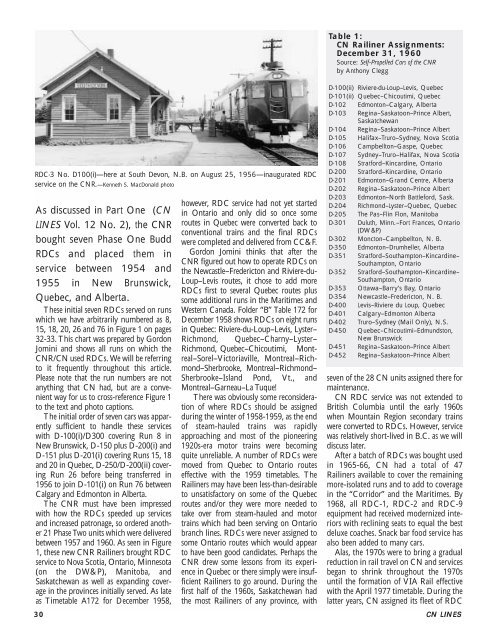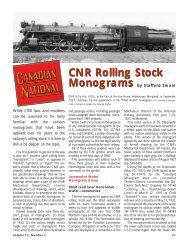CN LINES V12N3 - Canadian National Railways Historical Association
CN LINES V12N3 - Canadian National Railways Historical Association
CN LINES V12N3 - Canadian National Railways Historical Association
Create successful ePaper yourself
Turn your PDF publications into a flip-book with our unique Google optimized e-Paper software.
RDC-3 No. D100(i)—here at South Devon, N.B. on August 25, 1956—inaugurated RDC<br />
service on the <strong>CN</strong>R.—Kenneth S. MacDonald photo<br />
As discussed in Part One (<strong>CN</strong><br />
<strong>LINES</strong> Vol. 12 No. 2), the <strong>CN</strong>R<br />
bought seven Phase One Budd<br />
RDCs and placed them in<br />
service between 1954 and<br />
1955 in New Brunswick,<br />
Quebec, and Alberta.<br />
These initial seven RDCs served on runs<br />
which we have arbitrarily numbered as 8,<br />
15, 18, 20, 26 and 76 in Figure 1 on pages<br />
32-33. This chart was prepared by Gordon<br />
Jomini and shows all runs on which the<br />
<strong>CN</strong>R/<strong>CN</strong> used RDCs. We will be referring<br />
to it frequently throughout this article.<br />
Please note that the run numbers are not<br />
anything that <strong>CN</strong> had, but are a convenient<br />
way for us to cross-reference Figure 1<br />
to the text and photo captions.<br />
The initial order of seven cars was apparently<br />
sufficient to handle these services<br />
with D-100(i)/D300 covering Run 8 in<br />
New Brunswick, D-150 plus D-200(i) and<br />
D-151 plus D-201(i) covering Runs 15, 18<br />
and 20 in Quebec, D-250/D-200(ii) covering<br />
Run 26 before being transferred in<br />
1956 to join D-101(i) on Run 76 between<br />
Calgary and Edmonton in Alberta.<br />
The <strong>CN</strong>R must have been impressed<br />
with how the RDCs speeded up services<br />
and increased patronage, so ordered another<br />
21 Phase Two units which were delivered<br />
between 1957 and 1960. As seen in Figure<br />
1, these new <strong>CN</strong>R Railiners brought RDC<br />
service to Nova Scotia, Ontario, Minnesota<br />
(on the DW&P), Manitoba, and<br />
Saskatchewan as well as expanding coverage<br />
in the provinces initially served. As late<br />
as Timetable A172 for December 1958,<br />
however, RDC service had not yet started<br />
in Ontario and only did so once some<br />
routes in Quebec were converted back to<br />
conventional trains and the final RDCs<br />
were completed and delivered from CC&F.<br />
Gordon Jomini thinks that after the<br />
<strong>CN</strong>R figured out how to operate RDCs on<br />
the Newcastle–Fredericton and Riviere-du-<br />
Loup–Levis routes, it chose to add more<br />
RDCs first to several Quebec routes plus<br />
some additional runs in the Maritimes and<br />
Western Canada. Folder “B” Table 172 for<br />
December 1958 shows RDCs on eight runs<br />
in Quebec: Riviere-du-Loup–Levis, Lyster–<br />
Richmond, Quebec–Charny–Lyster–<br />
Richmond, Quebec–Chicoutimi, Montreal–Sorel–Victoriaville,Montreal–Richmond–Sherbrooke,<br />
Montreal–Richmond–<br />
Sherbrooke–Island Pond, Vt., and<br />
Montreal–Garneau–La Tuque!<br />
There was obviously some reconsideration<br />
of where RDCs should be assigned<br />
during the winter of 1958-1959, as the end<br />
of steam-hauled trains was rapidly<br />
approaching and most of the pioneering<br />
1920s-era motor trains were becoming<br />
quite unreliable. A number of RDCs were<br />
moved from Quebec to Ontario routes<br />
effective with the 1959 timetables. The<br />
Railiners may have been less-than-desirable<br />
to unsatisfactory on some of the Quebec<br />
routes and/or they were more needed to<br />
take over from steam-hauled and motor<br />
trains which had been serving on Ontario<br />
branch lines. RDCs were never assigned to<br />
some Ontario routes which would appear<br />
to have been good candidates. Perhaps the<br />
<strong>CN</strong>R drew some lessons from its experience<br />
in Quebec or there simply were insufficient<br />
Railiners to go around. During the<br />
first half of the 1960s, Saskatchewan had<br />
the most Railiners of any province, with<br />
Table 1:<br />
<strong>CN</strong> Railiner Assignments:<br />
December 31, 1960<br />
Source: Self-Propelled Cars of the <strong>CN</strong>R<br />
by Anthony Clegg<br />
D-100(ii) Riviere-du-Loup–Levis, Quebec<br />
D-101(ii) Quebec–Chicoutimi, Quebec<br />
D-102 Edmonton–Calgary, Alberta<br />
D-103 Regina–Saskatoon–Prince Albert,<br />
Saskatchewan<br />
D-104 Regina–Saskatoon–Prince Albert<br />
D-105 Halifax–Truro–Sydney, Nova Scotia<br />
D-106 Campbellton–Gaspe, Quebec<br />
D-107 Sydney–Truro–Halifax, Nova Scotia<br />
D-108 Stratford–Kincardine, Ontario<br />
D-200 Stratford–Kincardine, Ontario<br />
D-201 Edmonton–Grand Centre, Alberta<br />
D-202 Regina–Saskatoon–Prince Albert<br />
D-203 Edmonton–North Battleford, Sask.<br />
D-204 Richmond–Lyster–Quebec, Quebec<br />
D-205 The Pas–Flin Flon, Manitoba<br />
D-301 Duluth, Minn.–Fort Frances, Ontario<br />
(DW&P)<br />
D-302 Moncton–Campbellton, N. B.<br />
D-350 Edmonton–Drumheller, Alberta<br />
D-351 Stratford–Southampton–Kincardine–<br />
Southampton, Ontario<br />
D-352 Stratford–Southampton–Kincardine–<br />
Southampton, Ontario<br />
D-353 Ottawa–Barry’s Bay, Ontario<br />
D-354 Newcastle–Fredericton, N. B.<br />
D-400 Levis–Riviere du Loup, Quebec<br />
D-401 Calgary–Edmonton Alberta<br />
D-402 Truro–Sydney (Mail Only), N.S.<br />
D-450 Quebec–Chicoutimi–Edmundston,<br />
New Brunswick<br />
D-451 Regina–Saskatoon–Prince Albert<br />
D-452 Regina–Saskatoon–Prince Albert<br />
seven of the 28 <strong>CN</strong> units assigned there for<br />
maintenance.<br />
<strong>CN</strong> RDC service was not extended to<br />
British Columbia until the early 1960s<br />
when Mountain Region secondary trains<br />
were converted to RDCs. However, service<br />
was relatively short-lived in B.C. as we will<br />
discuss later.<br />
After a batch of RDCs was bought used<br />
in 1965-66, <strong>CN</strong> had a total of 47<br />
Railiners available to cover the remaining<br />
more-isolated runs and to add to coverage<br />
in the “Corridor” and the Maritimes. By<br />
1968, all RDC-1, RDC-2 and RDC-9<br />
equipment had received modernized interiors<br />
with reclining seats to equal the best<br />
deluxe coaches. Snack bar food service has<br />
also been added to many cars.<br />
Alas, the 1970s were to bring a gradual<br />
reduction in rail travel on <strong>CN</strong> and services<br />
began to shrink throughout the 1970s<br />
until the formation of VIA Rail effective<br />
with the April 1977 timetable. During the<br />
latter years, <strong>CN</strong> assigned its fleet of RDC<br />
30 <strong>CN</strong> <strong>LINES</strong>



